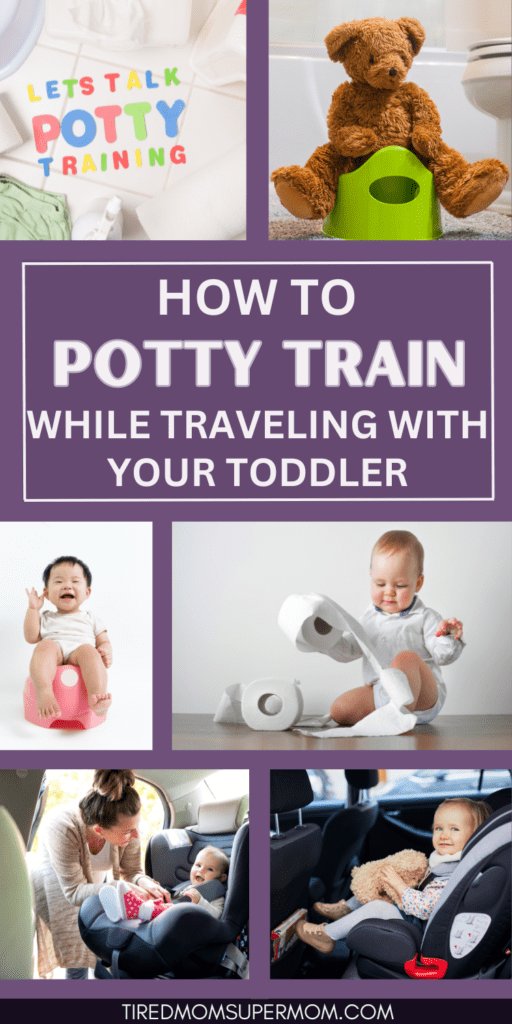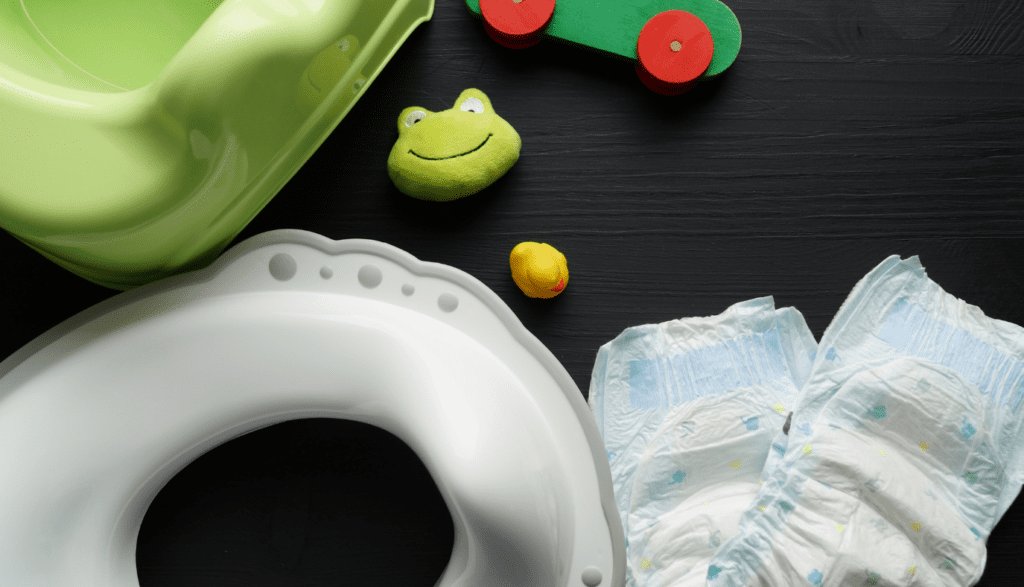Potty Training While Traveling: Essential Tips for Stress-Free Journeys
Potty training is already a major milestone at home — but doing it on the road? That’s a whole new level of parenting magic.
Whether you’re flying across the country or road-tripping to grandma’s, potty training while traveling doesn’t have to mean disaster. With the right tools, mindset, and prep, you can make it work (and even keep your sense of humor intact).
Here’s your complete guide to potty training while traveling — filled with real-life hacks, gear recs, and sanity-saving tips from moms who’ve done it.
Heads up: This post may include affiliate links. As an Amazon Associate, I earn from qualifying purchases—at no extra cost to you. Full privacy policy and disclosure here.

How To Potty Train While Travelling
If you’re dreading potty training while traveling, you’re not alone — but a few smart tips can turn chaos into calm.
One of the essential items to have in your arsenal is a portable potty seat.
Another important tip is to come prepared with backups.
Accidents happen, especially during potty training.
So be sure to pack extra clothes and underwear to handle any unforeseen mishaps.
Talking to your child about the trip and what to expect can help reduce anxiety and make them feel more at ease when using public bathrooms.
To make public bathrooms feel less intimidating, you can consider covering automatic flushers and providing headphones for noise-sensitive children.
Making potty training fun whenever possible and keeping essentials like wet wipes and hand sanitizer accessible are also important for a successful potty training journey while traveling.
Preparing to Travel with a Potty Training Toddler
Choosing the right gear can make potty training while traveling a whole lot easier, especially when you’re dealing with unpredictable stops or busy airports.
Here are some tips to help make your journey smoother:
- Choose your first outing carefully: When planning your first trip, opt for a location that is within a short drive and where accidents won’t be a big deal, such as a park or playground. This way, you’ll have easy access to a bathroom and can minimize any stress or anxiety.
- Bring a travel potty seat: Consider investing in a portable travel potty or a folding potty training seat. These handy gadgets provide a familiar and comfortable spot for your child to use the bathroom, even in unfamiliar environments. I like this one with it’s very own bag.
- Be prepared for accidents: Accidents are a normal part of potty training, so pack extra clothes and underwear to have on hand. This way, you can quickly change your child if an accident occurs and avoid any disruptions to your travel plans. This potty cleanup kit is just perfect.

Potty Training on an Airplane
Potty training on an airplane can be a challenge, but with the right strategies and preparations, it can be manageable. (If you’re too nervous, bring a pull up, it’s short term!)
Here are some tips to make the experience smoother:
| Tips | Description |
|---|---|
| Take your child to the bathroom before boarding | Encourage them to empty their bladder and bowels. |
| Make frequent trips to the restroom during the flight | Encourage your child to use the toilet regularly. |
| Use a portable travel potty | Consider using a portable potty seat provided by the airline or bring your own. |
| Be prepared with pull-ups | Bring pull-ups or diapers as a backup for accidents. |
| Communicate with flight attendants | Ask for assistance if needed and handle accidents with their support. |
| Pack a potty training travel kit | Include essentials like wet bags, extra pants, wipes, and hand sanitizer. |
Must-Have Items for Potty Training on the Go
When traveling with a potty-training toddler, having the right tools can make all the difference. Packing a few essentials can turn potential disasters into manageable moments. Here are the must-have items you should include in your travel kit:
- Portable Potty Seat: A portable potty seat, like the Potette Plus, is a game-changer. It’s lightweight, folds up easily, and gives your child a familiar and comfortable place to go, whether you’re at a rest stop, a park, or a public restroom. Some portable seats even come with disposable liners, making cleanup a breeze.
- Travel-Friendly Potty Chair: If your child isn’t comfortable with public restrooms, consider bringing along a travel potty chair. These compact, foldable chairs can be used anywhere and help avoid the anxiety some children feel in unfamiliar bathrooms.
- Wet Wipes and Hand Sanitizer: These are non-negotiable. Wet wipes are perfect for quick cleanups after an accident, while hand sanitizer ensures that little hands stay germ-free, especially when soap and water aren’t readily available.
- Extra Clothes and Underwear: Accidents are bound to happen, so it’s always a good idea to pack a few extra sets of clothes and underwear. Keep them easily accessible so you can handle any situation with minimal fuss.
- Disposable Toilet Seat Covers: Public restrooms can be intimidating, and cleanliness is often a concern. Disposable toilet seat covers provide a hygienic barrier, making it easier for your child to use the bathroom comfortably.
- Plastic Bags: Keep a few plastic bags on hand for storing soiled clothes until you can wash them. They’re also great for disposing of used wipes or liners discreetly. I use doggy poop bags for this!
Handling Potty Training Regressions During Travel
Traveling can be stressful for toddlers, and this stress sometimes leads to potty training regressions.
Suddenly, your little one who was doing so well at home is having accidents again.
Don’t worry—regressions are a normal part of the potty training process, especially when routines are disrupted. Here’s how to handle them effectively:
- Stay Calm and Positive: It’s easy to get frustrated when regressions happen, especially on the road, but staying calm is crucial. Remember, your child is likely feeling anxious too. Reassure them that accidents are okay and that you’re there to help them.
- Stick to a Routine: Try to maintain your child’s usual potty routine as much as possible. If they’re used to sitting on the potty after meals or before bedtime, continue this routine even while traveling. Consistency helps reinforce their training and gives them a sense of security.
- Offer Frequent Potty Breaks: During travel, offer potty breaks more frequently than you would at home. This reduces the chances of accidents and helps your child stay on track. Even if they say they don’t need to go, encourage them to try whenever you have the opportunity.
- Use Pull-Ups as a Backup: If your child is newly potty-trained and you’re worried about accidents, especially during long journeys or overnight stays, consider using pull-ups as a backup. These can help ease anxiety for both you and your child, while still allowing them to practice using the potty.
- Acknowledge and Praise Successes: Celebrate your child’s successes, no matter how small. Whether it’s making it to the potty on time or staying dry for a few hours, positive reinforcement goes a long way in boosting their confidence and keeping them motivated.
- Address Fears and Anxieties: Sometimes, regressions occur because of fear—whether it’s a fear of unfamiliar bathrooms, loud automatic flushers, or even the toilet itself. Talk to your child about their fears and try to address them with solutions, like covering the flusher with a sticky note or offering noise-canceling headphones.
- Plan for Downtime: Travel can be overwhelming for toddlers. Make sure to include some downtime where they can relax and recharge. A well-rested child is less likely to experience regressions.
📌 FAQs About Potty Training While Traveling
One of the most common concerns parents have about potty training while traveling is how to manage setbacks without losing progress.
Should I bring a portable potty seat when traveling with a potty training toddler?
Yes, having a portable potty seat, such as the Potette or bumble bee travel potty, can provide a familiar and safe spot for your child to use the potty in various public restrooms.
How can I prepare for outings with a newly potty trained toddler?
To prepare for outings with a newly potty trained toddler, start with short drives and choose locations where accidents won’t be a big deal, like parks or playgrounds. Bring a travel potty or folding potty training seat for your child’s comfort.
What should I do if my potty training toddler has an accident while traveling?
If your potty training toddler has an accident while traveling, be prepared by bringing extra clothes and underwear. Consider staying in accommodations with access to laundry facilities. Communicate your potty training routine with caregivers if your child will be staying with them.
How can I handle potty training on an airplane?
When potty training on an airplane, take your child to the bathroom before boarding and make frequent trips during the flight. Use a travel potty seat provided by the airline or bring your own portable option. Be prepared with pull-ups or diapers as a backup.
What essentials should I pack for potty training while traveling?
Essentials for potty training while traveling include wet wipes, hand sanitizer, extra pants and underwear, and a potty training travel kit with wet bags to contain any accidents.
What age is best for potty training on a trip?
Ideally, your toddler should be fairly confident with potty use before a big trip. Ages 2.5–3.5 are common, but readiness is more important than age.
What if my toddler regresses during travel?
That’s totally normal. Use pull-ups temporarily, offer extra encouragement, and return to routines once home.
What’s the best travel potty?
The OXO Tot 2-in-1 Go Potty is a top choice. It’s foldable, easy to clean, and kid-approved.
Can I skip public bathrooms altogether?
Yes — a good travel potty allows you to skip sketchy rest stops or hold-offs on planes. Just pull over or pop open your potty in the trunk or bathroom stall.
Do I need to bring the potty into hotels or rental homes?
Absolutely! Familiarity helps with comfort and routine. Even if there’s a toilet, bringing your child’s potty or seat can ease nerves.
Conclusion
Remember, the goal of potty training while traveling isn’t perfection — it’s progress, flexibility, and keeping your child feeling supported on the go.
Potty training while traveling can be a challenge, but with the right tips and tools, it can be a successful and stress-free experience.
